

End of the car age: how cities are outgrowing the automobile. Gilles Vesco calls it the “new mobility”.

It’s a vision of cities in which residents no longer rely on their cars but on public transport, shared cars and bikes and, above all, on real-time data on their smartphones. He anticipates a revolution which will transform not just transport but the cities themselves. “The goal is to rebalance the public space and create a city for people,” he says. “There will be less pollution, less noise, less stress; it will be a more walkable city.” Vesco, the politician responsible for sustainable transport in Lyon, played a leading role in introducing the city’s Vélo’v bike-sharing scheme a decade ago. Vesco is nothing if not an evangelist. The Vélo’v scheme is being extended, car clubs that use electric vehicles are being encouraged, and what Vesco calls a “collaborative platform” has been built to encourage ride-sharing by matching drivers with people seeking lifts. “Multi-modal” and “interconnectivity” are now the words on every urban planner’s lips. The-value-of-public-space. China paves the way for a new definition of urban farming.
Mar 22, 2015.
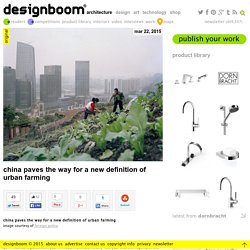
Biophilia will definitely change your way of designing forever. Biophilia is considered to be the missing link in sustainable design.

Biophilia aims to provide space for respectful and enriching relationships between human society and the natural world. Anyone looking for the key to a future of prosperity that respects the Earth and improves everybody’s life should know about biophilia. Community gardens, healing gardens, and even gardens for prisoners – all of these types of landscapes are designed with biophilia in mind. Biophilia is the last missing piece in the puzzle of sustainable and healthy cities.
Urban Agriculture in Cuba: Parts One and Two. Organoponicos.

Image by Alice Claydon. Growing more food in cities improves biodiversity, air pollution, green space, public health, food literacy, community engagement, employment prospects and urban regeneration. By Alice Claydon Landscape Institute Mar 6, 2015 Alice Claydon is one of three Student Travel Award 2014 recipients. She recently visited Cuba to investigate urban agriculture. Neighborhood Development and Grid Design.
Residents enjoy the healthy and liveable aspects of their neighbourhood.
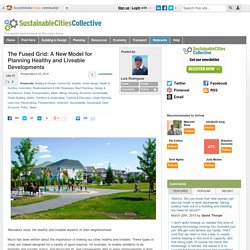
Much has been written about the importance of making our cities healthy and liveable. These types of cities are indeed designed for a variety of good reasons; for example, to enable residents to be mentally and socially active, and physically fit, and consequently able to enjoy improvements in their health, well-being and quality of life, which in turn can further lead to considerable savings in health care costs for them —individually— and their city. Green Roofs - Living Architecture Monitor - Spring 2015. Allotment (gardening) Typical allotments (called Schrebergärten in German) on the Käferberg hill in Zürich, Switzerland An allotment garden (British English),[1] often called simply an allotment, or a community garden (North America) is a plot of land made available for individual, non-commercial gardening or growing food plants.
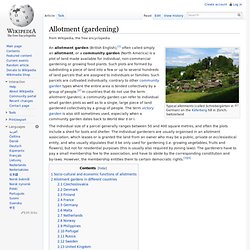
Such plots are formed by subdividing a piece of land into a few or up to several hundreds of land parcels that are assigned to individuals or families. Such parcels are cultivated individually, contrary to other community garden types where the entire area is tended collectively by a group of people.[2] In countries that do not use the term allotment (garden), a community garden can refer to individual small garden plots as well as to a single, large piece of land gardened collectively by a group of people.
The term victory garden is also still sometimes used, especially when a community garden dates back to World War II or I. No one likes a city that's too smart. This week London hosts a jamboree of computer geeks, politicians, and urban planners from around the world.
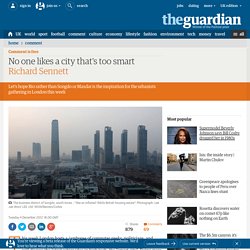
At the Urban Age conference, they will discuss the latest whizz idea in high tech, the "smart city". Doing more than programming traffic, the smart city's computers will calculate where offices and shops can be laid out most efficiently, where people should sleep, and how all the parts of urban life should be fitted together. New ‘Tactical Urbanism’ Book Signals the Way to Equitable, Funded City Planning. In some ways, tactical urbanism is a rejection of wonk — a way to show and not tell.
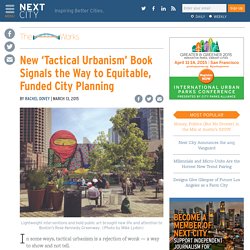
That characterization comes from a new book on the subject, Tactical Urbanism: Short-Term Action for Long-Term Change, by two of the buzz-term’s leading advocates, Mike Lydon and Anthony Garcia. Set for release March 17th, it delves into the phrase’s history, presenting trends, examples and stories from a movement still defining itself. It started with a South Florida city plan. Urban Permaculture Maximizes Garden Productivity. UN: Only Small Farmers and Agroecology Can Feed the World. Governments must shift subsidies and research funding from agro-industrial monoculture to small farmers using ‘agroecological’ methods, according to the UN’s Special Rapporteur on the Right to Food.
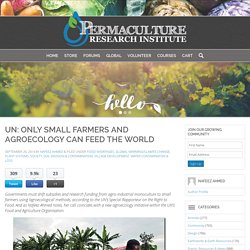
And as Nafeez Ahmed notes, her call coincides with a new agroecology initiative within the UN’s Food and Agriculture Organisation. Modern industrial agricultural methods can no longer feed the world, due to the impacts of overlapping environmental and ecological crises linked to land, water and resource availability. The stark warning comes from the new United Nations Special Rapporteur on the Right to Food, Prof Hilal Elver, in her first public speech since being appointed in June. “Food policies which do not address the root causes of world hunger would be bound to fail”, she told a packed audience in Amsterdam. One billion people globally are hungry, she declared, before calling on governments to support a transition to “agricultural democracy” which would empower rural small farmers. Dr. Rejoignez le CUBE, tiers-lieu dédié à l’Agriculture Urbaine et à la résilience à Paris.
La présence à Paris, notamment dans les arrondissements du nord-est, de nombreuses friches industrielles et de bâtiments désaffectés est à mettre en perspective avec le déficit de lieux d’expérimentation dédiés à l’agriculture urbaine et à la résilience dans la capitale. Saisissant l’opportunité du lancement du budget participatif et alors que la maire de Paris a annoncé vouloir faire de l’agriculture urbaine une des priorités de sa mandature, le collectif Babylone propose un projet à l’intersection des questions agricoles, alimentaires et sociales. Part Two: Should MoMA Tout Tactical Urbanism(s) as a Solution to Uneven Growth? In part one of this two-part blog post I asserted that an uncounted number of projects are being carried out globally under the banner of Tactical Urbanism.
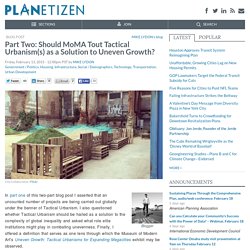
I also questioned whether Tactical Urbanism should be hailed as a solution to the complexity of global inequality and asked what role elite institutions might play in combating unevenness. Finally, I offered a definition that serves as one lens through which the Museum of Modern Art’s Uneven Growth: Tactical Urbanisms for Expanding Megacities exhibit may be observed. MoMA’s introduction to Uneven Growth, and the essays penned by academic heavyweights like Saskia Sassen and David Harvey for the companion publication, shed much light on the systemic failures of conventional city planning.
Magazin za zdraviji život, kulturu življenja, alternativnu medicinu i sudbine. Najčešće su u pravu oni koji tvrde da će beba imati plave oči. Food Production in Urban Spaces. Urban food gardens are a vital antidote to food deserts, writes Leonie Joubert in the sixth chapter of the Food Dialogues Report. Here she discusses what it takes to make a community food garden successful. Urban food gardens are an important way to help trickle-feed much-needed fresh produce into our kitchens. They are also a key way to remind urbanites, who are now so far removed from the soil that gives us our food, that growing food is something that needs time, dedication, skill and plenty of resources.
It teaches us the real value of food. While food garden initiatives are often well meaning, there are very real reasons why they fail. It’s useful to understand why some food gardens succeed, and why others fail, because it means we can be more intelligent about planning and rolling out other similar projects in future. Lamar Urban Farming Pavilion. Urban Farming Improving the Lives of Seniors. Spark Architects has come up with a unique urban farm concept called Homefarm, which is primarily aimed at improving the health and life of seniors at a Singapore retirement home.
Homefarm is an aquaponic system, which is easy to manage and therefore ideal for seniors to work on. According to the architects, the greatest potential of Homefarm lies in its ability to bring together two realms that are normally kept separate, namely the accommodation of seniors with urban farming. Singapore has an ageing population, as do most developed countries across the globe, and it imports more than 90 percent of its food. When employed, the Homefarm concept would take care of both of these issues at the same time.
Homefarm is a vertical aquaponic farm, in which the plants would be fertilized by the waste produced by fish also farmed alongside the vegetation. Article tags: alternative energy, aquaponics, conservation, farming, homefarm, water efficiency. In urban farming, a different taste of L.A. At the Jonathan Club downtown, not everyone took it well when an infrequently used paddle tennis court on a fifth-floor roof was sacrificed to gem lettuce, swiss chard and microgreens. Executive chef Jason McClain, of course, was thrilled. His father, a retired landscape architect, flew in from Alabama to build the garden, installing neat rows of galvanized horse troughs in which vegetables and herbs now grow. Club members walking on the artificial turf track nearby pass tubs filled with citrus and fruit trees.
The dinner menu lists "our home-grown items": broccolini, baby carrots, yuzu, blueberries, figs, snap peas and heirloom tomatoes. Rejoignez le CUBE, tiers-lieu dédié à l’Agriculture Urbaine et à la résilience à Paris. Cuba’s Urban Farming Revolution: How to Create Self-Sufficient Cities. Havanas’s unique agricultural infrastructure emerged from punishing trade sanctions following the fall of the USSR but today provides an exemplary precedent that could be applied worldwide When Cuba found itself abruptly cut off from trade with the Soviet bloc in 1989, the country entered into an economic crisis of unprecedented severity. Already sidelined from international trade due to US embargoes, Cuba became, almost overnight, a country detached from the rest of the world. In the years that followed, the tiny island nation struggled to export sugar and citrus fruits for more critical imports: the cereals, corn and meat that had become the staples of the Cuban diet.
7 Things You Should Know About Permaculture. What is permaculture? For those of you who’ve only heard of the term in passing, and even for you seasoned “permies” who struggle to explain this exciting (and sometimes life-changing) idea to others, here’s the gist in 7 points: 1. Permaculture is a Design System That Uses Ecosystem Principles to Meet Human Needs “If we throw mother nature out the window, she comes back in the door with a pitchfork.” - Masanobu Fukuoka, author of The One Straw Revolution. Image from naturalfarming.org Permaculture is an ecological systems theory. Permaculture looks closely at how ecosystems work and condenses those functions into twelve general principles. Humans are a part of the planet and cannot be separated from it.
If we are willing to learn from and work with nature, we can make smarter decisions to inform how we live. Can organic crops compete with industrial agriculture? A systematic overview of more than 100 studies comparing organic and conventional farming finds that the crop yields of organic agriculture are higher than previously thought. SPUR, David Chiu push SF urban gardens. URBAN AGRICULTURE Planners, proposed legislation push to streamline process Stephanie M. Urban farms, gardens, reforestation all part of Detroit Works vision for remaking city.
Cool Roofs Might Be Enough to Save Cities from Climate Overheating. Crickets chirp and bees buzz from sedum flower to flower atop the post office in midtown Manhattan during a visit to the 9th Avenue facility on a perfect New York City fall day. Urban gardens: The future of food? We Own The City: Enabling Community Practice In Architecture And Urban Planning. Earlier this year, our friends over at CITIES have launched their second book, We Own the City. The book is all about how traditional top-down players rethink their processes to enable more involvement from the local community. Urbani vrtovi trebaju ući u prostorne planove. Creativity, Humour and Sustainability. Humour has the power to cut through conflict, and art has the power to bypass reason. Cartoons equal art plus humour. So all credit to the 4th Future of Cities Forum for using comics to log in real time what delegates were debating and concluding in their workshops last week. Drawnalism is the name of the artist who was commissioned, who in reality is two people: the cartoonists Matt Buck and Alex Hughes.
Assembly-members-jonesj-docs-secure_food.pdf. Www.eurau12.arq.up.pt/sites/default/files/492.pdf. TUE A7 Food Cities_Designing Edible Landscapes for Urban Environments.pdf. EdibleCities.pdf. 10 The Edible City Katrin Bohn and Andre Viljoen.pdf. Hackable Cities: A Toolkit for Re-Imagining Your Neighborhood by Paige Gildner. UN Report Says Small-Scale Organic Farming Only Way To Feed The World. Can We Do Full-Scale Farming Inside City Centers? MONTREAL, Canada — In 1999, Dickson Despommier, a professor of environmental health sciences and microbiology at Columbia University, popularized the idea of large-scale urban agriculture by releasing a conceptual model for vertical farms. Crops would grow inside tall city buildings, using very little land to produce bounties of food that would not need to be shipped far to be eaten. With nine billion people worldwide to feed by 2050, and close to 70 percent of them residing in cities, bringing food production into dense urban areas had long been seen as a logical step toward sustainable living, and Despommier’s work seemed to take us in the right direction.
Fifteen years later, despite many experiments with farming inside city buildings, the first large-scale vertical farm, as envisioned by Despommier, has yet to be built. The urban farming industry, still in its infancy, is struggling to address the engineering challenges that make growing food in cities a costly business. Theory of City Form. Let’s make suburbs into cities: New urbanism, car culture and the future of community.
30Fayetteville_2030_Food_City_Scenario_Report.pdf. In a successful modern city, the car must no longer be king. American Society of Agronomy. Urpl.wisc.edu/ecoplan/content/lit_urbanag.pdf. Continuous Productive Urban Landscapes: Designing Urban Agriculture for ... - Google Books. Sustainablecities.org.nz/wp-content/uploads/Final-Thesis-with-Appendix-13th-Nov-09.pdf. Metro Vancouver: Designing for Urban Food Production. Www.heartfoundation.org.au/SiteCollectionDocuments/Food-sensitive-planning-urban-design-full-report.pdf. Www.refbc.com/sites/default/files/Urban-Farming-Guidebook-2013.pdf. Spatial planning and urban agriculture: Spatial Planning and Food - Wageningen UR.
Potential environmental and population health impacts of local urban food systems under climate change: a life cycle analysis case study of lettuce and chicken. Asi.ucdavis.edu/resources/publications/UA Lit Review- Golden Reduced 11-15.pdf. Pam Warhurst: How we can eat our landscapes. COST Action: Urban Allotment Gardens in European Cities – Future Challenges and Lessons Learned (2) Growing Cities: Let's Get Urban Farming on PBS by Dan Susman & Andrew Monbouquette. Urban Allotment Gardens / Urban Allotment Gardens. Urban Allotment Gardens in European Cities - Future, Challenges and Lessons Learned.
In a successful modern city, the car must no longer be king. Why the 'Garden City' Is Making an Unlikely Comeback. The History of Public Health — A New Era of Urban Planning. Ideal Cities. How More Bike Parking Could Make Cities Better For Everyone. Bees in the City! Why Urban Bees Can Transform Our Cities and Create Thriving Ecosystems. The Von Thunen Model. Podgorica Podgorica. 5 Epic Community Initatives From Around The World. ON REGARDE OÙ POUR PENSER L'INNOVATION ARCHITECTURALE DE DEMAIN ? How art and chickens revived Amsterdam's most unloved district. E. HOWARD, GARDEN CITIES OF TO-MORROW. Sevilla, paradise on two wheels. Types of Healthy Settings. How does urban planning influence public health? — A New Era of Urban Planning.
Urban farms won’t feed us, but they just might teach us. Want to breathe new life into your city? Build a fence around it. AGRO VESTI by agronews.rs – Tržišna ekonomija na mala vrata stiže na Kubu. Gradske bašte ili kako Beograd promeniti na bolje. Urbana poljoprivreda (2) Vitalni značaj organske hrane - Ekologija. Urbana poljoprivreda – Uzgajanje riba i povrća u gradovima. Urbana Poljoprivreda. Urbana poljoprivreda. Urbana agrokultura - proizvodnja hrane u naseljenim sredinama - Građevinarstvo.
Www.bk.tudelft.nl/fileadmin/Faculteit/BK/Onderzoek/Publicaties/Urbanism_research_programme_summary_2013.1.pdf. Forum.eionet.europa.eu/european-soundscape-award/library/cultivating-urban-sound-norway/cultivating-urban-sound-oslo/download/1/MAAG_europeansoundscapeaward.pdf?action=view. Results of the 2014 European Prize for Urban Public Space. Ecological citizenship and a plan for sustainable development - City - Volume 12, Issue 2. Transparent cities: Re‐shaping the urban experience through interactive video game simulation - City - Volume 13, Issue 4.
Urbanism in the anthropocene: Ecological urbanism or premium ecological enclaves? - City - Volume 14, Issue 3. Assemblage urbanism and the challenges of critical urban theory - City - Volume 15, Issue 2. Taylor & Francis Online. Carolyn Steel: How food shapes our cities. A blog by Gehl Architects. The 100 "Best" Books on City-Making Ever Written?
Site:edu urban planning master thesis. Department of Urban & Regional Planning. Recommended Urban Design Texts : urbandesign. Упутство за успех у животу : Културни додатак. Nu Hier. Google1.gif (800×8848)